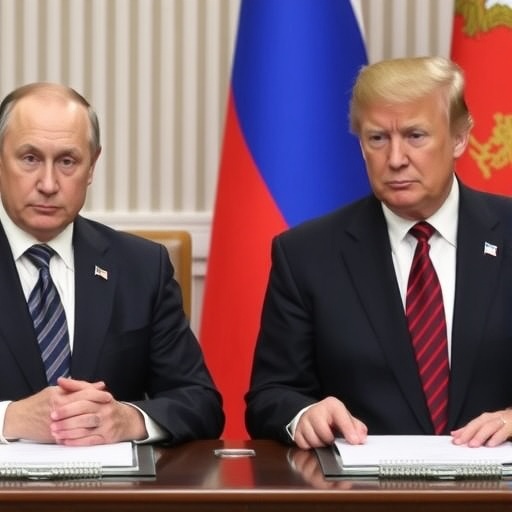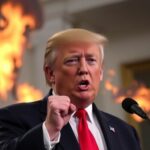Trump Cancels Putin Summit as Ukraine War Intensifies: No Meeting Until Peace Deal Emerges
In a dramatic turn amid the relentless drumbeat of conflict, former U.S. President Donald Trump has abruptly called off a highly anticipated summit with Russian President Vladimir Putin, declaring that no face-to-face talks will happen until a concrete peace deal is secured in the escalating Ukraine war. This decision, announced late Thursday, underscores the deepening chasm between Washington and Moscow, as battlefield hostilities show no signs of abating and diplomatic hopes flicker dimly.
Trump, who has long positioned himself as a deal-maker capable of brokering peace where others have failed, made the announcement via a statement on his Truth Social platform. “Until there’s a real peace deal for Ukraine, there’s no point in a summit with Putin,” he wrote, emphasizing his frustration with the ongoing stalemate. The cancellation comes just weeks after initial reports of a potential meeting surfaced, raising eyebrows among global leaders eager for any breakthrough in the conflict that has ravaged Europe since Russia’s full-scale invasion in February 2022.
Behind the Scenes: The Fragile Planning of a Trump-Putin Summit
The envisioned Trump-Putin summit was initially floated as a potential game-changer in U.S.-Russia relations, with whispers of secret backchannel communications fueling speculation. Sources close to Trump’s transition team revealed that preliminary discussions had advanced to the point of selecting neutral venues, including possibilities in Turkey or Switzerland, locations previously used for high-stakes diplomacy. However, the rapid escalation in Ukraine derailed these efforts, turning what could have been a historic reconnection into a symbol of irreconcilable differences.
Diplomatic insiders point to a series of preconditions set by both sides that proved insurmountable. Trump insisted on tangible progress toward a ceasefire, including Russian troop withdrawals from key Ukrainian territories like Kherson and Zaporizhzhia. Putin, on the other hand, demanded recognition of annexed regions, a non-starter for the incoming U.S. administration. A senior advisor to Trump, speaking anonymously, described the collapse as inevitable: “We weren’t going to sit down for photo ops while bombs fall on Kyiv. A summit without substance is just theater.”
This isn’t the first time Trump and Putin have danced around direct engagement. During Trump’s presidency, their 2018 Helsinki summit drew criticism for its perceived coziness, but it yielded little on concrete issues like election interference or arms control. Now, with Trump poised to return to the White House in January 2025, the stakes are even higher, as his “America First” agenda clashes with the moral and strategic imperatives of supporting Ukraine against Russian aggression.
Battlefield Realities Fueling the Ukraine War’s Escalation
The Ukraine war, now in its third year, has seen a surge in intensity that directly precipitated the summit’s demise. Recent weeks have witnessed ferocious Russian advances in the Donbas region, where Moscow’s forces have captured the strategic town of Vuhledar after months of grueling assaults. Ukrainian President Volodymyr Zelenskyy reported over 1,200 civilian casualties in the past month alone, with drone strikes hitting energy infrastructure and leaving millions without power as winter looms.
According to the latest figures from the United Nations, the conflict has displaced more than 6.5 million Ukrainians internally and driven another 3.9 million to seek refuge abroad. Military analysts from the Institute for the Study of War note that Russia has mobilized an additional 300,000 troops since September, bolstered by alliances with North Korea and Iran for munitions supplies. On the Ukrainian side, Western aid—totaling over $100 billion from the U.S. and EU—has enabled counteroffensives, but ammunition shortages and fatigue are taking a toll.
A poignant example of the war’s human cost came from a viral video shared by Ukrainian troops: a soldier recounting the loss of his entire platoon in a single artillery barrage near Avdiivka. “Every day is a gamble with death,” he said, his words echoing the desperation that makes any peace deal seem distant. Experts warn that without de-escalation, the winter could turn into a frozen hell, with both sides digging in for prolonged attrition warfare.
Trump’s Shifting Rhetoric on Putin and the Path to Peace
Donald Trump’s approach to Vladimir Putin has always been a mix of admiration for the Russian leader’s toughness and criticism of his actions in Ukraine. In recent campaign speeches, Trump boasted he could end the Ukraine war “in 24 hours,” a claim that drew skepticism from foreign policy hawks. Yet his latest statement marks a hardening: no summit until a peace deal materializes, signaling a departure from his earlier calls for immediate negotiations.
White House officials under President Biden, whose term ends soon, expressed cautious support for Trump’s pivot. National Security Advisor Jake Sullivan stated, “Any diplomatic effort must prioritize Ukraine’s sovereignty; we’re glad to see alignment on that front.” Meanwhile, Republican senators like Lindsey Graham have urged Trump to leverage economic sanctions, which have already cost Russia an estimated $300 billion in frozen assets and trade disruptions.
Looking at potential frameworks for a peace deal, analysts reference the Istanbul talks of 2022, where early agreements on neutrality and territorial compromises nearly materialized before collapsing. Trump has hinted at reviving such ideas, possibly involving guarantors like China or India. However, Putin’s recent speeches, including one at the Valdai Forum where he vowed to “defend our gains,” suggest Moscow’s intransigence. A peace deal, if achievable, might involve phased withdrawals, security assurances for both nations, and reconstruction aid estimated at $500 billion by the World Bank.
Global Echoes: How the World Reacts to the Summit Snub
The cancellation of the Trump-Putin summit has rippled across international capitals, eliciting a spectrum of reactions from relief to regret. In Kyiv, Zelenskyy hailed the move as a “principled stand,” tweeting, “True peace requires justice, not concessions to aggression.” European allies, still reeling from energy crises triggered by the Ukraine war, see it as a reinforcement of NATO’s resolve; German Chancellor Olaf Scholz announced an additional €5 billion in military aid, emphasizing unity against Russian expansionism.
Conversely, voices in the Global South, including Brazilian President Lula da Silva, lamented the lost opportunity for dialogue. “Summits like this could bridge divides,” Lula said during a BRICS meeting, where Putin attended virtually. In Moscow, Kremlin spokesperson Dmitry Peskov downplayed the snub, claiming, “President Putin is always open to talks, but on equal terms.” This rhetoric masks internal pressures on Putin, as Russia’s economy grapples with 7% inflation and a ruble devaluation amid sanctions.
U.S. domestic politics also factor in, with polls from Pew Research showing 58% of Americans favoring reduced involvement in Ukraine. Trump’s decision could rally his base, portraying him as tough on foreign entanglements, while critics like Senate Minority Leader Chuck Schumer warn it risks emboldening Putin further.
Charting the Course: Future Prospects for Ukraine Diplomacy
As the dust settles on the canceled summit, eyes turn to what comes next in the quest for a peace deal. Trump’s incoming administration plans to ramp up bilateral talks with Ukraine and European partners, potentially hosting a reconstruction summit in Washington to signal long-term commitment. Intelligence reports suggest quiet diplomatic feelers through intermediaries like Turkey’s President Erdogan, who mediated grain export deals last year.
Yet challenges abound. The Ukraine war’s toll—over 500,000 combined military casualties, per British defense estimates—has entrenched positions. A breakthrough might hinge on U.S. incentives, such as easing sanctions in exchange for verifiable ceasefires. Forward-looking scenarios from the RAND Corporation outline three paths: a frozen conflict with armistice lines, a comprehensive settlement redrawing borders, or escalated involvement drawing in NATO directly.
For ordinary Ukrainians, like the residents of bomb-sheltered Lviv interviewed by CNN, the hope is fading but not gone. “We need leaders who fight for us at the table, not just on the field,” one mother said, cradling her child amid blackout drills. As Trump prepares to reassume power, the world watches whether his deal-making prowess can finally illuminate a path out of the shadows cast by the Ukraine war. The absence of a summit isn’t an end, but a recalibration—one that demands creativity, compromise, and unyielding resolve to secure lasting peace.








